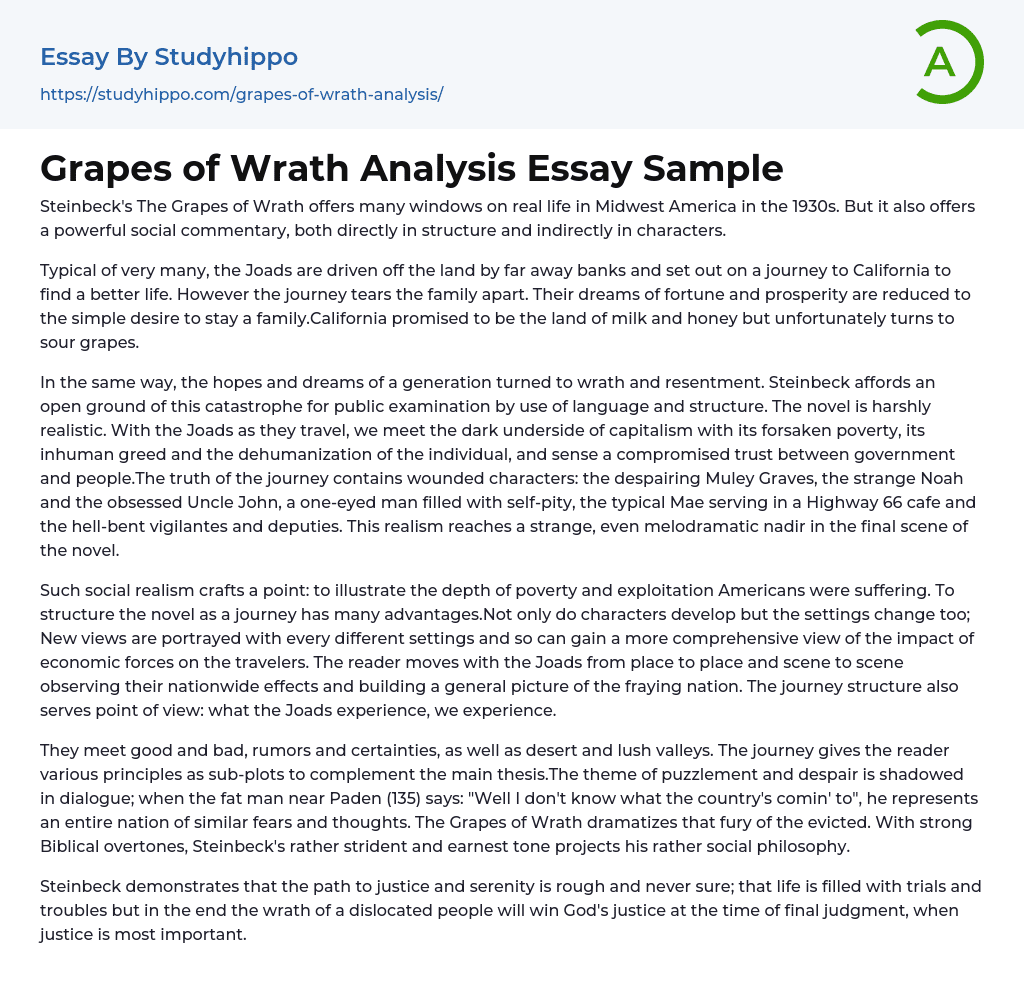The Grapes of Wrath by Steinbeck provides numerous insights into daily life in 1930s Midwest America. Additionally, it serves as a forceful critique of society, evident in both its structure and its portrayal of characters.
Similar to countless other families, the Joads are forced to leave their land by remote banks and embark on a trip towards California in search of a brighter future. Nevertheless, the journey leads to the disintegration of the family. Whereas they had hoped for wealth and success, all they ultimately yearn for is to remain united as a family. Despite its initial promise of prosperity, California ultimately proves to be a disappointment.
Steinbeck's novel exposes the transformation of a generation's hopes and dreams into wrathful resentment. Through language and structure, the author presents a brutally realistic depiction of the Joad family's travels, revealing the darker as
...pects of capitalism such as poverty, greed, and dehumanization. This journey also exposes the breakdown of trust between government and people, and introduces wounded characters such as Muley Graves, Noah, Uncle John, Mae, as well as vigilantes and deputies. The novel concludes with a climactic scene that reaches an even more intense level of realism and melodrama.
The purpose of social realism is to depict the extent of poverty and exploitation that Americans were undergoing. Employing a journey as the novel's structural framework offers various benefits. Not only do the characters evolve, but the surroundings also change. Every different setting introduces new perspectives, providing a more inclusive representation of the impact of economic forces on the travelers. Following the Joads from location to location, the reader witnesses their nationwide repercussions and gains a comprehensive understanding o
a crumbling nation. Furthermore, the journey structure enables us to experience what the Joads encounter.
Throughout the journey depicted in The Grapes of Wrath, the characters encounter both positive and negative experiences, ranging from rumors to certainties, as well as both arid and fertile landscapes. Along the way, various sub-plots emerge that complement the primary thesis. One recurring theme is a sense of confusion and hopelessness, which is reflected in dialogue such as the fat man's statement near Paden: "Well I don't know what the country's comin' to." This sentiment reflects a larger fear and anxiety felt by many in the nation. Ultimately, The Grapes of Wrath showcases the rage and struggle of those who have been forcibly evicted. Steinbeck imbues his writing with Biblical allusions, and his fervent tone underscores his strong social philosophy.
In his work, Steinbeck illustrates that achieving justice and inner peace is a challenging and uncertain journey. He emphasizes that life is riddled with difficulties and hardships; however, the fury of a displaced community will ultimately prevail over God's judgment during the ultimate reckoning of justice.
- Book Summary essays
- Metaphor essays
- Reader essays
- Rhyme essays
- Literary devices essays
- Villain essays
- Books essays
- Genre essays
- Literary Criticism essays
- Writer essays
- Protagonist essays
- Simile essays
- Poem essays
- Book Report essays
- Book Review essays
- Greek Mythology essays
- Plot essays
- Tragic Hero essays
- Coming of Age essays
- Play essays
- Rhetoric essays
- Rhetorical Question essays
- Translation essays
- Understanding essays
- Reason essays
- Character essays
- Letter essays
- American Literature essays
- Literature Review essays
- Utopia essays
- Poetry Analysis essays
- Dante's Inferno essays
- Between The World and Me essays
- Incidents in The Life of a Slave Girl essays
- Flowers for Algernon essays
- Myth essays
- Everyday Use essays
- Boo Radley essays
- Genesis essays
- Richard iii essays
- Alice in Wonderland essays
- On the road essays
- Ozymandias essays
- The Nightingale essays
- Holden Caulfield essays
- Animal Farm essays
- 1984 essays
- A Hanging essays
- Shooting An Elephant essays
- A Tale Of Two Cities essays




